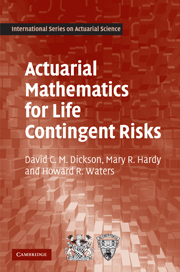Book contents
- Frontmatter
- Contents
- Preface
- 1 Introduction to life insurance
- 2 Survival models
- 3 Life tables and selection
- 4 Insurance benefits
- 5 Annuities
- 6 Premium calculation
- 7 Policy values
- 8 Multiple state models
- 9 Pension mathematics
- 10 Interest rate risk
- 11 Emerging costs for traditional life insurance
- 12 Emerging costs for equity-linked insurance
- 13 Option pricing
- 14 Embedded options
- A Probability theory
- B Numerical techniques
- C Simulation
- References
- Author index
- Index
2 - Survival models
- Frontmatter
- Contents
- Preface
- 1 Introduction to life insurance
- 2 Survival models
- 3 Life tables and selection
- 4 Insurance benefits
- 5 Annuities
- 6 Premium calculation
- 7 Policy values
- 8 Multiple state models
- 9 Pension mathematics
- 10 Interest rate risk
- 11 Emerging costs for traditional life insurance
- 12 Emerging costs for equity-linked insurance
- 13 Option pricing
- 14 Embedded options
- A Probability theory
- B Numerical techniques
- C Simulation
- References
- Author index
- Index
Summary
Summary
In this chapter we represent the future lifetime of an individual as a random variable, and show how probabilities of death or survival can be calculated under this framework. We then define an important quantity known as the force of mortality, introduce some actuarial notation, and discuss some properties of the distribution of future lifetime. We introduce the curtate future lifetime random variable. This is a function of the future lifetime random variable which represents the number of complete years of future life. We explain why this function is useful and derive its probability function.
The future lifetime random variable
In Chapter 1 we saw that many insurance policies provide a benefit on the death of the policyholder. When an insurance company issues such a policy, the policyholder's date of death is unknown, so the insurer does not know exactly when the death benefit will be payable. In order to estimate the time at which a death benefit is payable, the insurer needs a model of human mortality, from which probabilities of death at particular ages can be calculated, and this is the topic of this chapter.
We start with some notation. Let (x) denote a life aged x, where x ≥ 0. The death of (x) can occur at any age greater than x, and we model the future lifetime of (x) by a continuous random variable which we denote by Tx.
- Type
- Chapter
- Information
- Actuarial Mathematics for Life Contingent Risks , pp. 17 - 40Publisher: Cambridge University PressPrint publication year: 2009



